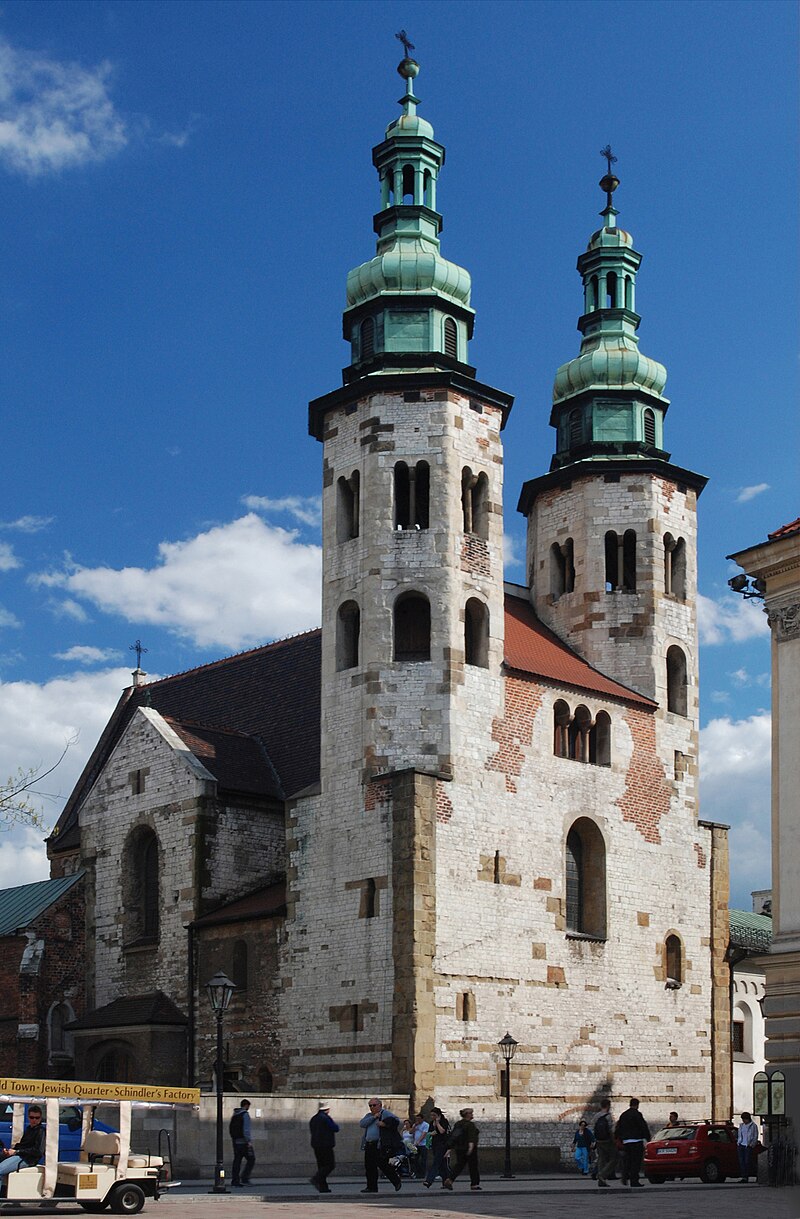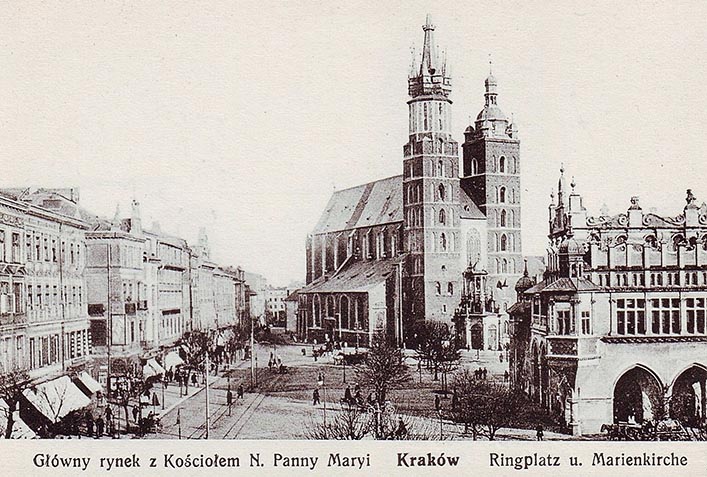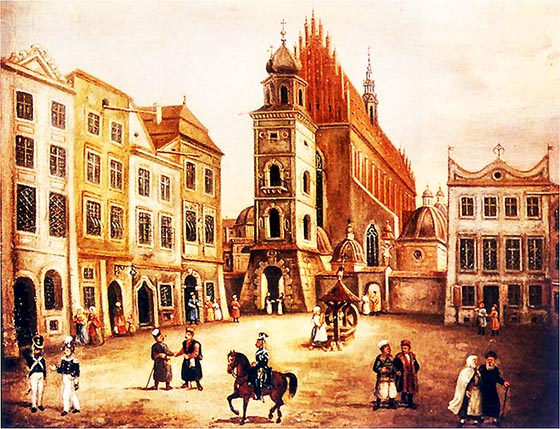 Skałka to wzgórze z jurajskiego wapienia nieopodal Wawelu, na którym jeszcze przed XI w. istniał ośrodek kultowy Wiślan. W XI w. wybudowano na tym miejscu romańską świątynię, która w 1079 r. była świadkiem jednego z najsłynniejszych i najbardziej zagadkowych mordów w historii Polski. Rozpowszechniana od stuleci legenda, poparta autorytetem Galla Anonima, głosi, że król polski, Bolesław Śmiały, skazał biskupa krakowskiego, Stanisława ze Szczepanowa, na karę śmierci za zdradę stanu. Legenda precyzuje ze szczegółami rodzaj śmierci, jaka spotkała Stanisława; śmiertelny cios zadano mu mieczem przy ołtarzu świątyni, ciało zaś wywleczono na zewnątrz i posiekano na pniu. Są rozbieżności co do dalszych losów szczątków męczennika, jedna wersja upiera się przy wrzuceniu ich do pobliskiej sadzawki, inna zmierza ku Wiśle. W każdym razie ciało pochowano w kościele Na Skałce, gdzie spoczywało przez 10 lat. W 1089 r. przeniesiono je do Katedry Wawelskiej. Niedługo po śmierci biskupa Bolesław Śmiały z przyczyn nie do końca wyjaśnionych opuści! na zawsze kraj. W roku 1253, a więc ponad 170 lat po tragicznych wydarzeniach, Kościół katolicki w osobie papieża Innocentego IV kanonizował męczennika, po czym świętego Stanisława ze Szczepanowa obrano głównym patronem Królestwa Polskiego. Pozycja tego człowieka w panteonie polskich świętych jest szczególna: przed jego trumną na Wawelu koronowano władców Polski, którzy potem odbywali pieszą pielgrzymkę z Wawelu na Skałkę, aby w ten sposób odpokutować czyn Bolesława Śmiałego. Jednak wielu historyków nabiera coraz wyraźniejszych podejrzeń, że postać biskupa nie była tak świetlista, a znaczenie jego śmierci – aż tak oczywiste. Wysuwa się zarzut, że biskup sprzeniewierzył się władzom Kościoła, zaś fakt jego śmierci wykorzystano do rozgrywek politycznych. Na poparcie tego ostatniego przytacza się argument późnej daty kanonizacji św. Stanisława – prawie 200 lat po śmierci – oraz to, że wcześniejsze źródła nawet nie wspominają o tragicznym końcu biskupa. Kult świętego przetrwał do naszych czasów, wywierając wpływ na architekturę kościoła Na Skałce oraz na znaczenie tej świątyni jako ośrodka kultu.
Skałka to wzgórze z jurajskiego wapienia nieopodal Wawelu, na którym jeszcze przed XI w. istniał ośrodek kultowy Wiślan. W XI w. wybudowano na tym miejscu romańską świątynię, która w 1079 r. była świadkiem jednego z najsłynniejszych i najbardziej zagadkowych mordów w historii Polski. Rozpowszechniana od stuleci legenda, poparta autorytetem Galla Anonima, głosi, że król polski, Bolesław Śmiały, skazał biskupa krakowskiego, Stanisława ze Szczepanowa, na karę śmierci za zdradę stanu. Legenda precyzuje ze szczegółami rodzaj śmierci, jaka spotkała Stanisława; śmiertelny cios zadano mu mieczem przy ołtarzu świątyni, ciało zaś wywleczono na zewnątrz i posiekano na pniu. Są rozbieżności co do dalszych losów szczątków męczennika, jedna wersja upiera się przy wrzuceniu ich do pobliskiej sadzawki, inna zmierza ku Wiśle. W każdym razie ciało pochowano w kościele Na Skałce, gdzie spoczywało przez 10 lat. W 1089 r. przeniesiono je do Katedry Wawelskiej. Niedługo po śmierci biskupa Bolesław Śmiały z przyczyn nie do końca wyjaśnionych opuści! na zawsze kraj. W roku 1253, a więc ponad 170 lat po tragicznych wydarzeniach, Kościół katolicki w osobie papieża Innocentego IV kanonizował męczennika, po czym świętego Stanisława ze Szczepanowa obrano głównym patronem Królestwa Polskiego. Pozycja tego człowieka w panteonie polskich świętych jest szczególna: przed jego trumną na Wawelu koronowano władców Polski, którzy potem odbywali pieszą pielgrzymkę z Wawelu na Skałkę, aby w ten sposób odpokutować czyn Bolesława Śmiałego. Jednak wielu historyków nabiera coraz wyraźniejszych podejrzeń, że postać biskupa nie była tak świetlista, a znaczenie jego śmierci – aż tak oczywiste. Wysuwa się zarzut, że biskup sprzeniewierzył się władzom Kościoła, zaś fakt jego śmierci wykorzystano do rozgrywek politycznych. Na poparcie tego ostatniego przytacza się argument późnej daty kanonizacji św. Stanisława – prawie 200 lat po śmierci – oraz to, że wcześniejsze źródła nawet nie wspominają o tragicznym końcu biskupa. Kult świętego przetrwał do naszych czasów, wywierając wpływ na architekturę kościoła Na Skałce oraz na znaczenie tej świątyni jako ośrodka kultu.
Żelazna brama, wykuta w 1894 r., przez którą wchodzi się od ul. Skałecznej na teren klasztoru Paulinów, zapowiada wrażenia estetyczne czekające zwiedzających. Za bramą otwiera się widok na barokową fasadę o dwóch symetrycznych wieżach i charakterystycznych „zamaszystych” schodach wiodących na wyższy poziom kościoła św. Michała. Patrząc na wybujałe kształty i rozmiary fasady, można spodziewać się wiele po wnętrzu, które tymczasem okazuje się ciasne, choć niezwykle interesujące.
W prezbiterium znajduje się jeden z bardziej eleganckich krakowskich ołtarzy barokowych. Ma zielonkawo-kremowe kolumny i figury aniołów ze słusznej wielkości skrzydłami. Pośrodku widnieje obraz z XVIII w. przedstawiający św. Michała Archanioła, patrona świątyni. Jednak ważniejszy od głównego wydaje się ołtarz w lewej nawie (stojąc twarzą do prezbiterium), wykonany w 1745 r. z dębnickiego marmuru. Postawiono go w miejscu, gdzie – jak się uważa – 11 kwietnia 1079 r. święty Stanisław ze Szczepanowa odprawiał swoją ostatnią mszę i gdzie go zabito. W ołtarzu mieści się obraz przedstawiający św. Stanisława z mieczem wbitym w głowę. Trzeba przyznać, że ten wizerunek rozmija się z typowym wyobrażeniem o wyglądzie biskupa: ten na obrazie przypomina bardziej hiszpańskiego granda niż słowiańskiego świętego. W dolnej, oszklonej części ołtarza zabezpieczono część pnia, na którym 900 lat temu poćwiartowano wywleczonego z kościoła Stanisława, zaś bardziej na prawo, przez trzy okrągłe otwory można, choć z dużym trudem, wypatrzyć kamień zbroczony krwią męczennika.








